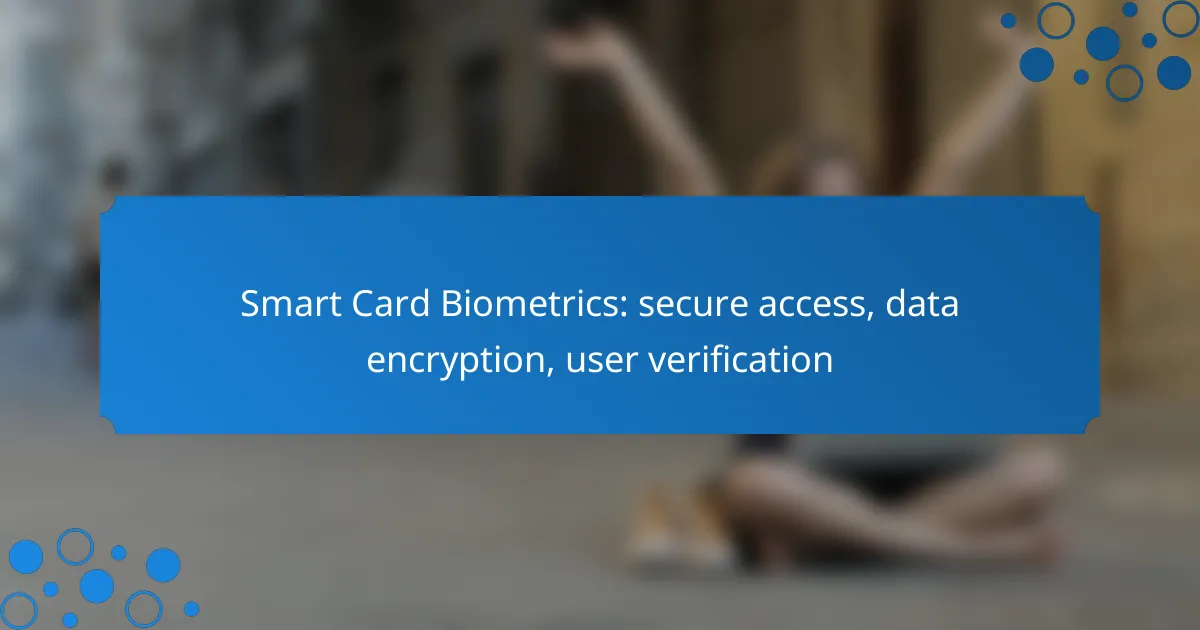Smart card biometrics represent a cutting-edge solution for secure access, combining physical card technology with advanced biometric verification methods. By integrating unique user characteristics such as fingerprints or facial recognition, these systems enhance data encryption and ensure that only authorized individuals can access sensitive information. This dual-layered approach significantly mitigates the risk of unauthorized access, making it an essential tool for safeguarding critical data and facilities.
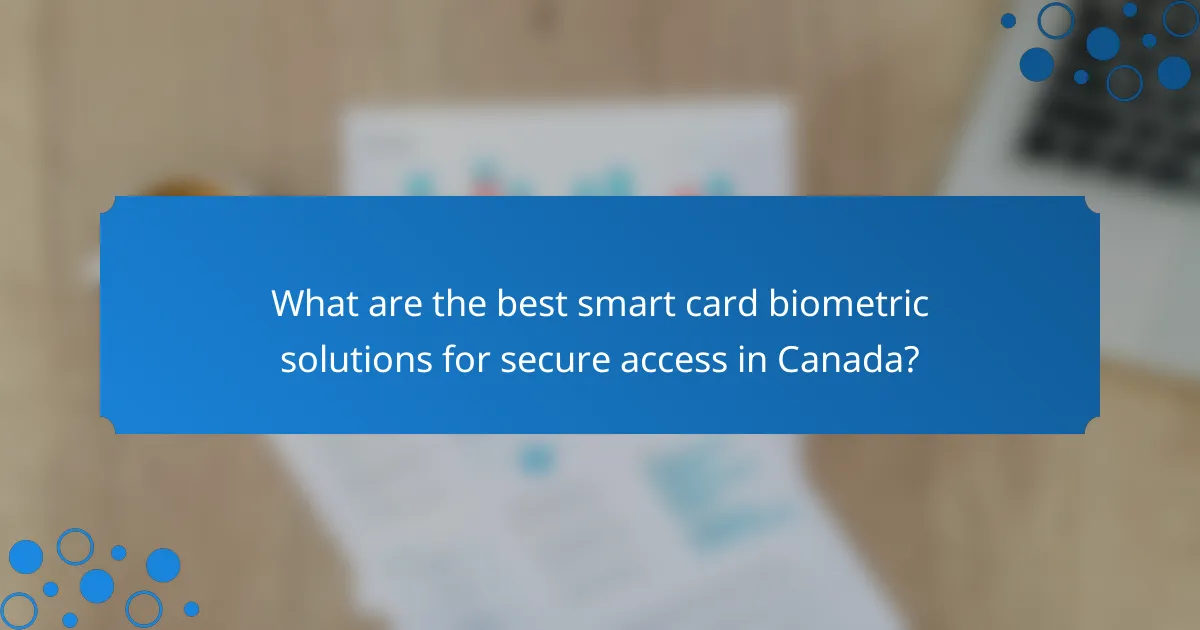
What are the best smart card biometric solutions for secure access in Canada?
The best smart card biometric solutions for secure access in Canada include advanced technologies that combine physical card access with biometric verification methods. These solutions enhance security by ensuring that only authorized users can access sensitive data and facilities.
Gemalto Smart Card Solutions
Gemalto offers a range of smart card solutions that integrate biometric authentication for secure access. Their products typically feature fingerprint recognition and facial recognition technologies, which are designed to provide a seamless user experience while ensuring high levels of security.
When considering Gemalto solutions, organizations should evaluate their specific security needs, as well as the scalability of the technology. These smart cards can be used in various applications, from corporate access control to government identification systems.
HID Global Biometric Access Control
HID Global provides biometric access control solutions that incorporate smart card technology for enhanced security. Their systems often utilize fingerprint scanning and facial recognition to verify user identity before granting access.
HID’s solutions are particularly suitable for environments requiring stringent security measures, such as financial institutions and government facilities. Users should be aware of the integration capabilities with existing security systems to ensure a smooth implementation process.
Fujitsu PalmSecure Technology
Fujitsu’s PalmSecure technology uses palm vein recognition as a biometric method for secure access. This innovative approach captures the unique vein patterns in a user’s palm, providing a high level of accuracy and security.
Organizations in Canada can benefit from Fujitsu’s solutions by reducing the risk of unauthorized access and enhancing user convenience. It’s essential to consider the environmental factors, such as lighting and hygiene, which may affect the performance of palm recognition systems.
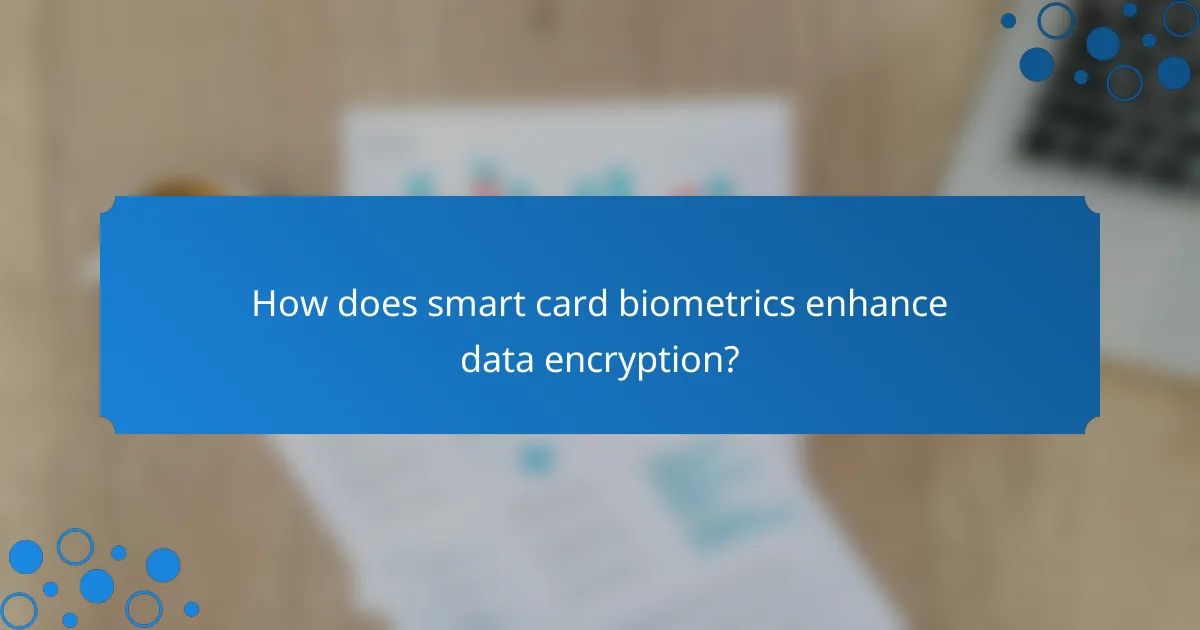
How does smart card biometrics enhance data encryption?
Smart card biometrics enhance data encryption by integrating unique physical characteristics of users, such as fingerprints or facial recognition, to secure access to sensitive information. This dual-layered approach ensures that only authorized individuals can decrypt and access data, significantly reducing the risk of unauthorized access.
Encryption Algorithms Used
Smart card biometrics typically employ advanced encryption algorithms such as AES (Advanced Encryption Standard) and RSA (Rivest-Shamir-Adleman). These algorithms provide robust security by transforming data into unreadable formats that can only be decrypted with the correct keys, which are often stored securely within the smart card itself.
Additionally, biometric data can be encrypted using hashing techniques, ensuring that even if the data is intercepted, it remains secure. Common hashing algorithms include SHA-256 and SHA-3, which are widely recognized for their effectiveness in protecting sensitive information.
Integration with Secure Access Systems
Integrating smart card biometrics with secure access systems enhances security protocols by requiring both possession of the smart card and the user’s biometric data for authentication. This two-factor authentication method is more secure than traditional password systems, as it combines something the user has (the card) with something the user is (biometric data).
Organizations should ensure that their access control systems are compatible with biometric smart cards. This may involve updating existing hardware and software to support biometric readers and encryption standards, which can vary based on regulatory requirements and industry standards.
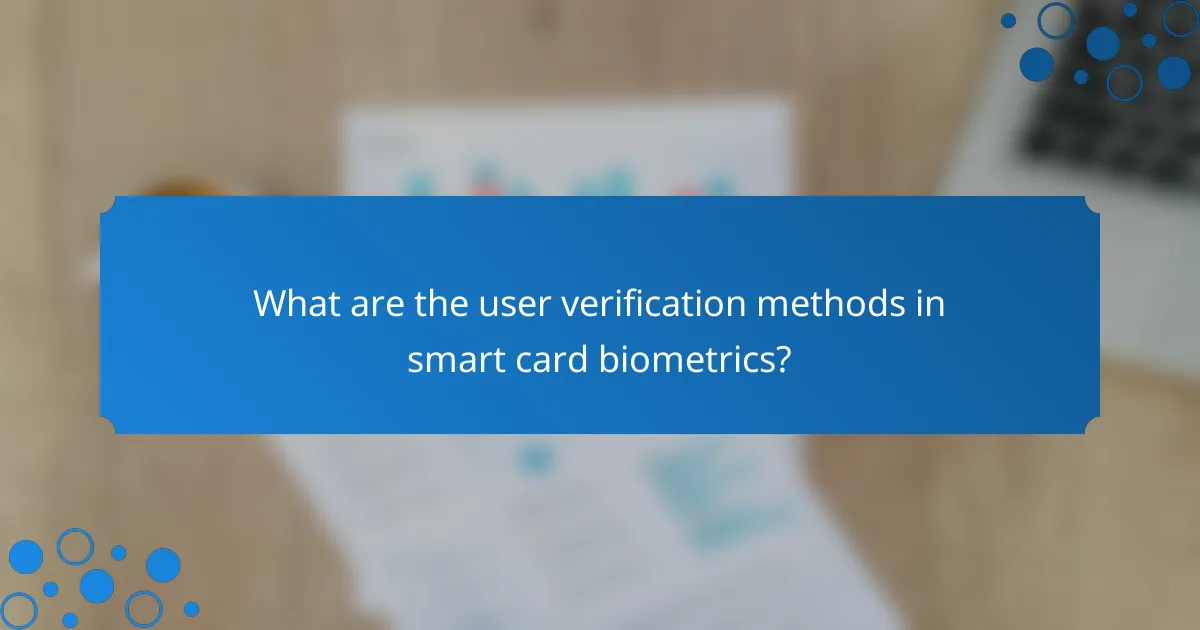
What are the user verification methods in smart card biometrics?
User verification methods in smart card biometrics primarily include fingerprint recognition and iris scanning. These techniques enhance security by ensuring that only authorized individuals can access sensitive data stored on smart cards.
Fingerprint Recognition
Fingerprint recognition involves capturing and analyzing the unique patterns of ridges and valleys on an individual’s fingertips. This method is widely used due to its ease of use and relatively low cost, making it a popular choice for various applications, including mobile devices and access control systems.
When implementing fingerprint recognition, consider the quality of the scanner, as lower-quality devices may struggle with accuracy. It’s also essential to ensure that the fingerprint data is encrypted to protect against unauthorized access. Regularly updating the biometric templates can help maintain system integrity.
Iris Scanning
Iris scanning uses high-resolution cameras to capture the unique patterns in the colored part of the eye. This method is known for its high accuracy and low false acceptance rates, making it suitable for high-security environments such as government facilities and financial institutions.
While iris scanning offers robust security, it typically requires more sophisticated and expensive hardware compared to fingerprint recognition. Users should be aware that environmental factors, such as lighting conditions and distance from the scanner, can affect the performance of iris recognition systems. Ensuring proper training for users can help mitigate these issues.

What are the benefits of using smart card biometrics?
Smart card biometrics provide enhanced security and user verification through unique physical traits, making unauthorized access significantly more difficult. They also streamline user experiences by integrating biometric data directly into access systems, reducing the need for multiple passwords or PINs.
Increased Security
Smart card biometrics enhance security by ensuring that only authorized users can access sensitive information or locations. Biometric traits, such as fingerprints or facial recognition, are unique to each individual, making it nearly impossible for someone to impersonate another user.
Implementing smart card biometrics often involves compliance with security standards like ISO/IEC 19794, which governs biometric data formats. Organizations should consider the integration of encryption protocols to protect biometric data during transmission and storage.
Streamlined User Experience
Smart card biometrics simplify the user experience by eliminating the need for passwords or physical keys. Users can gain access quickly and efficiently, often with just a fingerprint scan or facial recognition, which can take only a few seconds.
To maximize user satisfaction, organizations should ensure that biometric systems are user-friendly and reliable. Regular training and updates can help users adapt to these systems, minimizing frustration and enhancing overall productivity.

What are the challenges of implementing smart card biometrics?
Implementing smart card biometrics presents several challenges, including high costs, user adoption hurdles, and the need for robust security measures. Organizations must navigate these obstacles to successfully integrate biometric technology into their access control systems.
Cost of Deployment
The cost of deploying smart card biometrics can be significant, often involving expenses for hardware, software, and ongoing maintenance. Initial investments may range from several hundred to thousands of dollars per user, depending on the complexity of the system and the number of cards required.
Additionally, organizations should consider the costs associated with training staff and updating existing infrastructure to support biometric systems. Budgeting for these factors is crucial to avoid underestimating the total investment needed for a successful rollout.
User Adoption Issues
User adoption is a critical challenge when implementing smart card biometrics. Employees may resist changes to their access methods due to concerns about privacy, ease of use, or unfamiliarity with the technology. Effective communication and training are essential to alleviate these concerns and encourage acceptance.
To facilitate smoother adoption, organizations can implement pilot programs that allow users to experience the technology before full deployment. Gathering feedback during these trials can help address issues and improve user confidence in the new system.
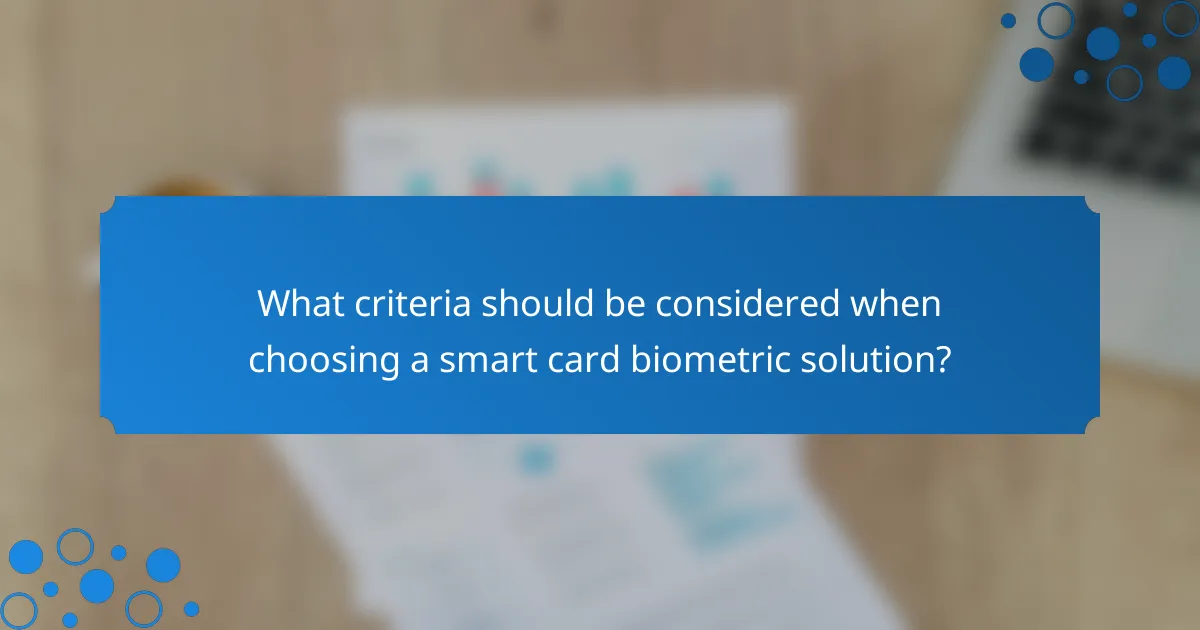
What criteria should be considered when choosing a smart card biometric solution?
When selecting a smart card biometric solution, consider factors such as security features, compliance with regulations, integration capabilities, and user experience. These criteria ensure that the solution meets organizational needs while providing reliable access control and data protection.
Compliance with Canadian Regulations
In Canada, biometric solutions must comply with privacy laws such as the Personal Information Protection and Electronic Documents Act (PIPEDA). This regulation mandates that organizations obtain consent for collecting biometric data and ensure its secure handling. Choosing a solution that adheres to these regulations is crucial to avoid legal issues and protect user privacy.
Additionally, consider how the solution aligns with industry-specific standards, such as those in finance or healthcare, which may have stricter requirements for biometric data management. Ensuring compliance not only builds trust with users but also mitigates potential risks associated with data breaches.
Integration Capabilities with Existing Systems
Effective integration with existing systems is essential for a smooth implementation of a smart card biometric solution. Assess whether the solution can seamlessly connect with current access control systems, databases, and user management platforms. This compatibility can significantly reduce deployment time and costs.
Look for solutions that offer APIs or support common protocols like ISO/IEC 7816 for smart cards. This flexibility allows for easier updates and scalability, ensuring that the system can adapt to future technological advancements or organizational changes.
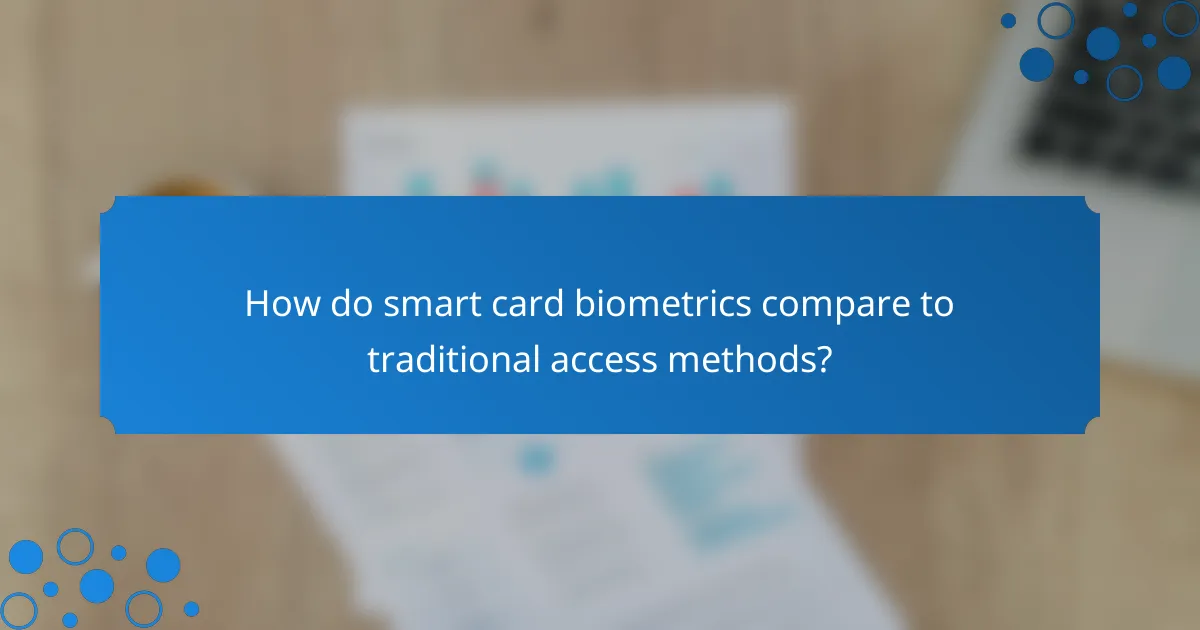
How do smart card biometrics compare to traditional access methods?
Smart card biometrics offer enhanced security and user verification compared to traditional access methods like PINs or passwords. By integrating biometric data, such as fingerprints or facial recognition, these cards provide a more reliable and user-friendly way to authenticate identity.
Security Effectiveness
Smart card biometrics significantly improve security by using unique biological traits that are difficult to replicate. Unlike traditional methods that can be easily forgotten or stolen, biometric data is inherently tied to the individual, making unauthorized access much harder. Additionally, smart cards often incorporate encryption, ensuring that sensitive data is protected during transmission.
Common security standards, such as ISO/IEC 19794 for biometric data interchange, help ensure interoperability and reliability. Organizations should consider implementing smart card biometrics to reduce the risk of identity theft and unauthorized access, especially in sectors like finance and healthcare where data protection is critical.
User Convenience
Smart card biometrics enhance user convenience by streamlining the authentication process. Users can gain access quickly without the need to remember complex passwords or PINs, which can be a barrier in traditional systems. This ease of use can lead to faster transactions and improved user satisfaction.
For example, biometric authentication typically takes only a few seconds, compared to the time spent entering passwords. Organizations should ensure that their biometric systems are user-friendly and provide clear instructions to maximize adoption and minimize frustration among users.
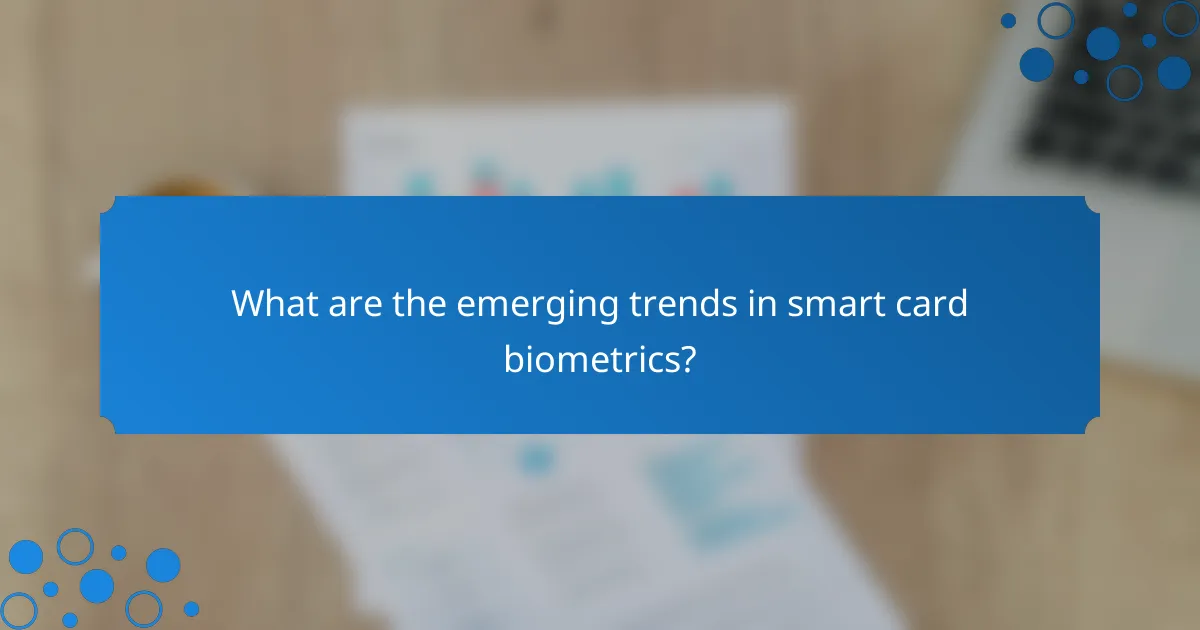
What are the emerging trends in smart card biometrics?
Emerging trends in smart card biometrics focus on enhancing security, improving user verification, and ensuring data encryption. These advancements include the integration of artificial intelligence, increased use of multi-factor authentication, and the development of more sophisticated biometric algorithms.
AI Integration for Enhanced Security
AI integration in smart card biometrics significantly boosts security by enabling real-time analysis and adaptive learning. AI algorithms can detect anomalies in user behavior, flagging potential fraud or unauthorized access attempts more effectively than traditional systems.
For instance, AI can analyze biometric data patterns, improving the accuracy of fingerprint or facial recognition systems. This leads to reduced false acceptance rates and enhances overall user verification processes.
Organizations should consider implementing AI-driven biometric systems, ensuring they stay updated with the latest algorithms and security patches. Regular audits and assessments can help identify vulnerabilities and maintain robust security measures.
